CHAPTER 8 - EXAMPLE MUSICAL ANALYSES
BRAHMS ST ANTONI CHORALE VARIATIONS
Step 2 - Identify the Surface Voice Leading
We can now examine the surface voice leading in more detail. If you are not familiar with voice leading analysis I suggest you read this in conjunction with the Voice Leading Appendix.
The voice leading analysis enables us to understand how the melodic structure of the music arises from the surface voice leading. The surface of the music is made up of voice leading patterns which combine to form motivic patterns. These are the smallest units of melody that combine to form larger melodic structures. The motivic patterns are developed throughout the melody to give the melody unity. If we strip away the voice leading surface, we uncover the underlying root progression patterns which give the music its musical phrase structures. An important aspect of voice leading, as demonstrated in the Voice Leading Appendix, is the fact that it can be built up in more than one layer, in places, but once the classical principles of voice leading are exhausted then what we are left with is the underlying root progression patterns which can't be explained by voice leading alone. This topic will be discussed in more detail in Chapter 10 of the book.
The piano reduction shows a summary of the voice leading and the resulting motivic elements. Voice leading patterns are shown as: 'A' for auxiliary note, 'P' for passing note etc. Motives are shown as a, b, c with horizontal square brackets. Where the same motive is repeated, altered in some way, These are shown it as a' and b' etc.
The intention of the motivic analysis here is to show how the surface voice leading creates melody and unity. I have kept this analysis simple and have not gone into too much detail about the way one motive is transformed into another. That would be the subject of a more detailed motivic analysis.
Phrase 1 (bars 1 to 5).
Please refer to the Brahms Piano Reduction and the first page of the Brahms Analytical Outline. I suggest you print off each of these. Please also refer to the Glossary of Symbols for a full explanation of all symbols used.
The voice leading patterns in the first two bars are two auxiliary notes (marked "A" in the following extract from the Piano Reduction).
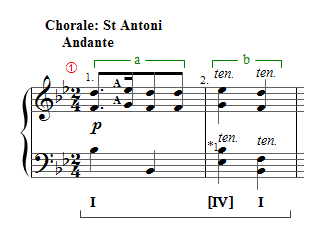
In the first bar, the auxiliary notes result in the melody and inner voice moving in 6ths, moving from notes of the tonic chord briefly to notes of the subdominant chord and back to notes of the tonic chord with no movement in the bass. But as this arises purely from voice leading, no change in structural chord is indicated in the analysis. However, in bar 2, chord IV is created in a similar way, but this time, the auxiliary notes have greater length, are on the first beat of the bar and are accompanied by a bass movement from the tonic to the subdominant and back. As a result of this bass movement, there is a change of chord root. This chord IV here carries greater structural weight as it arises out of root movement rather than pure voice leading. Consequently, the chord IV in bar 2 is notated as a auxiliary chord (which prolongs the tonic) in the Piano Reduction and Analytical Outline.
It is worth noting that Brahms has no qualms about scoring horn II (shown as *1 in the piano reduction) and the bass instruments in parallel 5ths thus flouting a voice leading convention in a way that would have been frowned on in earlier music. This demonstrates that the structure of the music (including the voice leading here) is not governed purely by arbitrary voice leading rules, rather it is governed by patterns in each of the three syntaxes working together to produce the overall structure of the music. However, Brahms does normally avoid parallel 5ths between outer voices. See Voice Leading Appendix, Independence of the Voices.
The first bar voice leading creates motive "a" which is made up of the dotted auxiliary note followed by the repeating note patterns as shown in green in the example above. (Note that the voice leading and rhythmic elements both contribute to the motive) This motive is developed and repeated throughout the whole movement, is the basis of the melody and gives the music unity.
The second important motive is the two note descending motive (motive "b") This is first introduced in bar 2, as follows:
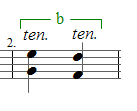
This is harmonised here by the chord change IV to I. But later, the pattern is used at several points in other ways, as can be seen in the piano reduction, as a voice leading pattern rather than a harmonic pattern. This motive is in fact a shortened version of motive "a" but with the important difference that the upper note is on the strong beat.
In bars 3 and 4, things are a little more complicated as the voice leading elaboration is in more than one layer. In order to identify the underlying root progression, we have to analyse the voice leading in two steps, as follows:
In bar 3, there are two passing notes in the bass (one chromatic, ascending and one diatonic, descending) as follows:
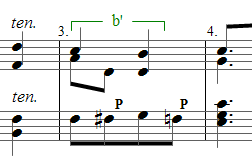
If we remove these from the score we can see the underlying structure is as follows:
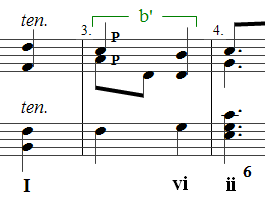
We can now see that the notes C and A are also passing notes which fill in between the notes of chord I and chord vi. It is easy to see that C is a passing note between D and Bb because these notes are in the same voice - the melody, but A can also be seen as a passing note if we recognise that Bb is a note of chord I and G is a note of chord vi. As these notes are both in the bass, Brahms avoids doubling them in the middle voices. These passing notes move against the stationary note F in the bass clef. We can now see that, since the C and A are passing notes, the D is an arpeggiation within chord I. These are shown as such in the Analysis Outline (see extract later) where arpeggios are shown with a slur symbol and passing notes as above.
What can cause confusion here is that the two passing notes C and A, in conjunction with the bass F form a triadic chord - chord V. It is easy to confuse this as a root movement from I to V but because it arises out of passing motion, it is, according to the principles of voice leading, a passing chord. It is important to say that this is not a special type of chord. The only purpose of describing it as a passing chord is to avoid the possible confusion that would arise out of concluding that it was a functional chord in its own right. It is, in reality, voice leading just like any other voice leading.
This voice leading in bar 3 results in a variant of motive b from bar 2. Shown as b'. Here, the descending pattern is made up of a tone rather than a semitone.
The voice leading in bar 4 to 5 is also built up in layers. In order to establish the underlying root progression, we have to remove the voice leading in two steps, as follows. Firstly, we can easily see that the melody ascends from C, via passing note D to Eb. This is a new motive "c". It shares the dotted rhythm with motive "a" but has more melodic movement than does motive a.
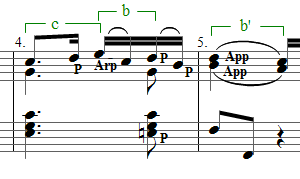
The Eb is a note of the underlying C minor chord which returns via an arpeggio to C. This is followed by two notes, D and Bb which imitate this motion. They are a similar arpeggiation of two passing notes which descend from Eb and C to the notes C and A of the dominant chord. The dominant chord is itself decorated by two appoggiaturas descending in 3rds. It is easier to see the voice leading pattern if we show the arpeggios from Eb to C and from D to Bb as parallel thirds and remove the appoggiaturas. This shows the parallel thirds descending from the Eb and C of the chord II to the C and A of the dominant chord, as follows:
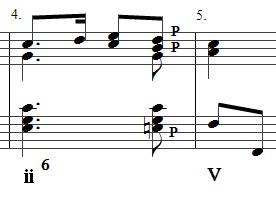
Now we can see that the D and Bb are passing notes between notes of chord II and the dominant chord. These thirds are arpeggiated to create the surface detail. At the same time, the bass moves in contrary motion ascending from Eb via an E natural passing note to F. This leaves an underlying chord progression which is chord II (in first inversion) to chord V. The rest is voice leading in two layers. This expansion of the harmony into arpeggios (in this case movement in thirds) is sometimes referred to as "unfolding" of the underlying harmonic or voice leading pattern. The voice leading is shown more clearly in the analytical outline.
The dominant chord of the cadence is not a simple chord V. It is decorated by voice leading in the form of two appoggiaturas. This is shown by the figured bass numbers in the analytical outline. This shows the 6th from the bass falling to the 5th from the bass and the 4th from the bass falling to the 3d from the bass, in parallel 3rds. What is special about this voice leading pattern is that the two appoggiaturas, in combination with the bass F make up the notes of the tonic chord (Bb, D and F) but the fact that it's the F that is in the bass indicates that this is not a structural tonic chord but the result of a dominant chord being decorated by voice leading. This is why I've notated this formation in the analytical outline as an appoggiatura chord. This very common use of the appoggiatura chord to decorate the dominant chord of the cadence is usually described as the cadential 6 4 chord because the chord has a 6th and a 4th above the dominant bass note. Like the passing chord, and other voice leading patterns, this can be used in conjunction with further layers of voice leading. In this case, the two passing notes in bar 4 anticipate the appoggiaturas which then resolve onto the structural notes of the dominant chord. See the examples in the voice leading appendix for further description of the cadential 6 4 chord.
This is represented in the analytical outline by slurs to show how the appoggiaturas are resolved and to indicate which structural notes they relate to.
This voice leading results in the motives as follows: The ascending C - D - Eb pattern is a new motive "c". The piano reduction also shows motive b and its variant b' in these two bars. The overall melodic movement from bar 4 to the first C in bar 5, represents an expansion of the original motive a. this links together the three main motives of this piece. This is shown in the piano reduction as a'.
The chromatic passing note pattern in the bass F - F # - G in bar 3 creates a variation of diatonic motive c and the descending passing note pattern G - F natural - Eb is also a descending variant of motive c. This illustrates the fact that voice leading patterns can lead to motivic patterns which can be used in the bass and middle voices just as in the main melodic line.
Phrase 2 (bars 6 to 10).
By now the reader should be able to follow the detailed voice leading and motivic patterns and underlying root progressions in the piano reduction and the in the analytical outline. So I will move more quickly through the remaining analysis.
We do not need to discuss the whole of phrase 2 because it is a repeat of phrase 1 but with a different ending. This time, the dominant chord, accompanied by its appoggiatura elaboration, appears in the same bar with chord II, and is followed by a tonic chord so that the phrase ends with the full V - I perfect cadence.
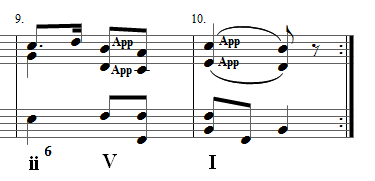
If we examine the final chord I in bar 10, we can see that this is also elaborated by two appoggiaturas, but here the appoggiaturas move from 9 to 8 above the bass and in parallel 6ths from 4 to 3 above the bass. This is indicated in the figuration in the analytical outline. There is also a fifth from the bass present which does not move with the appoggiaturas. Whereas the appoggiaturas to the chord V temporarily create the impression of a different chord, as discussed above, in bar 10 the appoggiaturas to chord I do not create the impression of any other chord because of the presence of the 5th of the chord. Here we have no need to describe this as an appoggiatura chord as it clearly just two appoggiaturas moving in parallel.
In reality, there is no difference between these two things. They are both examples of underlying structural chords elaborate by voice leading - appoggiaturas moving in parallel. However, the reason for making this distinction in the terminology is that the cadential 6 4 chord (elaboration of the dominant) could be confused as a separate chord (and this is done in some flawed theories of root progression) whereas the second cannot be confused as a separate structural chord. So it is useful to highlight appoggiatura chords, just to avoid this confusion, just as it is important to highlight passing chords which equally can be confused with structural chords. As for other types of voice leading, it is possible to further elaborate on this chord, creating two or three layers of voice leading. See notes on the Cadential 6 4 chord chord in the Voice Leading Appendix.
Phrase 3 (bars 11 to 18)
If we examine the voice leading in this section we will see that it is also made up in more than one layer. If we eliminate the auxiliary notes and repeated notes in each of the three bars this leave us with the following outline:
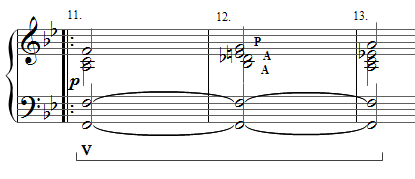
The chord in bar 11 is made up totally of the notes of the dominant chord and the chord in bar 13 is made up of the notes of the dominant 7th chord. However, the notes in bar 12 are made up of: a passing note in the top line (G passing between F and A); and in the middle voices, two auxiliary notes Bb and Db (auxiliary notes to the A and C of the dominant chord). There is, in addition, a chromatic linear progression which descends in a middle voice from the dominant, F to E natural in bar 12 to Eb in bar 13 which forms the 7th of the dominant 7th chord (F7). This linear progression creates a movement within the static dominant pattern which leads it to the tonic chord in bar 14 where the Eb moves a further chromatic step to D of the tonic chord. The notes of bar 12, in combination make up a diminished 7th chord over the F dominant pedal. These voice leading patterns are made against the stationary dominant note in the bass. We can thus see that these three bars are just voice leading patterns which decorate the underlying dominant chord. The dominant pedal emphasises this fact. Thus the dominant chord is prolonged by voice leading.
The voice leading patterns create motivic patterns in this section which are based on rising versions of motive "a", These are shown in the piano reduction.
Bar 14 is an example of a short prolongation of the tonic chord where the chord moves from one inversion to another. The move is from first inversion to root position. The two inversions are connected by voice leading made up of passing notes (Bb - C - D in the soprano and D - C - Bb in the bass) there is also an A auxiliary note (Bb - A - Bb) as indicated below:
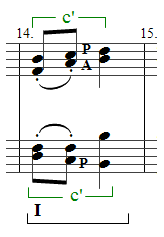
This is a short example of a common voice leading pattern. In the process of changing inversion, the notes of the bass are swapped with the notes of the melody. I.e. the Bb of the melody is transferred to the bass and the D of the bass is transferred to the melody. For this reason, this voice leading pattern is sometimes referred to as "voice exchange". This is shown as crossed arrows in the analytical outline
As the melodic line rises a major third, (rather than a minor third as in bar 4), this is a major third variation of the motive "c" from the first line. The melodic line in the bass descends a major third, in what is an inverted variation of motive "c". These are indicated in the piano reduction.
If we examine the voice leading in bars 15 to 17, we find again, that the voice leading is in more than one layer.
We can see that the melodic line is based on the ubiquitous motive "a" which now forms a descending sequence from bar 15 to bar 17.
If we remove the auxiliary notes and repeated notes in this section then we have the following outline:
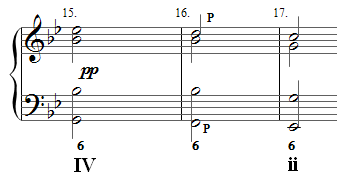
This reveals further voice leading movement. The D in the melody is a passing note between the Eb in bar 15 and the C in bar 17. The bass F is a passing note between the G in bar 15 and the Eb in bar 17. The two passing motions move in parallel in compound intervals of 6ths (octave plus 6th) between the melody and the bass. These are made against the stationary Bb's in the middle voices. This reflects the movement in 6ths highlighted earlier. The combination of notes in bar 16 is Bb, D, F. This is the tonic chord. However, as this is created by passing movement, it is in reality a passing chord which is just another example of voice leading. This voice leading pattern created by parallel movement between chords is similar to the Movement in 10ths described in the Voice Leading Appendix.
The voice leading pattern is shown as figuration under the score, indicating three successive intervals of (compound) 6ths from the bass, moving in parallel with each other and in oblique motion with the stationary Bb notes as is normally the case with voice leading moving in parallel intervals.
Once the voice leading movement is accounted for, we can see that the underlying root progression is a move from an Eb chord (chord IV) in first inversion, to the C minor (chord II) in first inversion.
Phrase 4 (bars 19 to 30)
Bars 19 to 22 are identical to the first four bars of phrase 2 except there is more octave doubling to increase the intensity of the music towards the end of the movement. In this instance, I've shown some of this doubling in the piano reduction to make clearer the voice leading in the ensuing bars. These bars take us to the dominant chord in bar 22.
Bars 23 to 30 contains a new extension to the melody. If we examine bars 23 to 24, in the piano reduction, we can see, again, that the voice leading here is in more than one layer. In the second half of bar 24 it is important to note that the second D is not just an auxiliary note to the Eb but is also part of a diatonic linear progression which descends: Eb - D - C - Bb which moves in oblique motion with the repeated Eb's and the sustained Bb's . There is a parallel movement in the tenor voice which descends: G - F - Eb - (D) this is in oblique motion with the repeated G's and sustained B's. The D is not present in this voice at the start of bar 25. As it is present in the treble melody voice. I've marked these linear progressions as passing notes in the piano reduction. If you examine an orchestral score, you will see that the two linear progressions actually move in parallel 6ths. I've shown them separated by a further octave in the piano reduction just so that you can play it on the piano if you wish. Removing this layer of voice leading leaves us with the following outline:
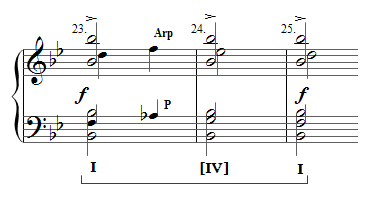
I've shown the doubling of the bass Bb an octave higher, in the tenor register because this enables us to see that the Ab note in bar 23 arises out of a passing motion from the Bb of the Bb tonic chord to the G of the Eb chord. This movement is the common chromatic passing note filling in between the chord I and chord IV. As it resides on the voice leading surface it does not imply modulation. This elaboration is common in I - IV - I progressions in both opening section static harmony and in prolongations of the tonic chord in the cadence. See later section for further notes on this. This leaves us with an underlying root progression which is the static I - IV - I pattern. This makes reference to, and elaborates on, the I - IV- I pattern in the opening of the theme, thus adding to the unity of the musical content. This descent from Bb to Ab to G is shown in the analytical outline with the symbols usually used for linear progressions in order to make things clearer. (In any case, a passing note is just a linear progression with only one passing note involved).
The motivic content of this section is shown in the piano reduction where it can be seen that this prolongation of the final tonic chord is carried out using motives a and c thus providing further unity with and development of the earlier melodic material.
Bars 27 to 28 (four repeated chords) is motive "a" reduced to an even simpler form. The last sustained chord is extended in length because it represents the same motive reduced to a single chord. The tonic chord is thus prolonged from bar 23 to the last bar.
Next Section - Chord Progression Analysis

